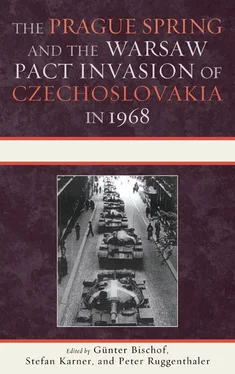From the spring of 1968 onward, the Kremlin’s apprehensions with regard to Czechoslovakia’s domestic political situation became ever more urgent. The same was true of the demands presented to Dubček and his government. As a first step, the Politburo nominated a small working group that was to address the situation in the ČSSR. After the group’s first briefing at the Politburo session on 6 May 1968, Mikhail Suslov, Pyotr Demichev, Konstantin Katushev, and Konstantin Rusakov were asked to prepare “a proper information sheet on the situation in Czechoslovakia for the party of the CPSU” and to brief journalists on how to present developments in the press and how to account for them to the public.
The USSR Ministry for Foreign Affairs was ordered to prepare a draft for a TASS report to counter the “false rumors with regard to Masaryk’s death that were being circulated by the ČSSR’s press and radio.” It was to contain the information that Andropov had already forwarded in a letter to the CC CPSU on 25 April 1968 stating that the discussion fanned by the Czechoslovak mass media—it was claimed that Masaryk had not committed suicide, as was announced in 1948, but had been murdered by the KGB on Stalin’s orders—was based on empty speculations. 25According to Andropov, it was obvious in the light of new archival research that there was “no connection whatever” between the organs of the Soviet Secret Service (the Committee for Information, KI) and Masaryk’s suicide; therefore, the campaign in Czechoslovakia had to stop. 26However, Section 4 of the Politburo resolution of 6 May is evidence, if veiled in the code of bureaucratic jargon, that this resolution was, in fact, the key to the development that followed and the precondition for the military intervention:
Comrades Suslov, Andropov, Demichev, Ustinov, Katushev, Ponomaryov, Grechko, Gromyko, Epishev, and Rusakov are to be asked to prepare drafts for the required documents. This also applies to the measures as discussed for the implementation thereof, which will include plans for the concrete steps to be taken according to the situation in the country after the afore mentioned measures have been carried out. 27
In plain language, this referred to drawing up a plan for the military option, including a time schedule and a detailed listing of all the measures required (“concrete steps”) after the invasion (“after the aforementioned measures have been carried out”). At that stage, the purely military aspect had already been resolved. A detailed plan for the invasion of Czechoslovakia by Soviet troops (together with orders for the 38th Army) was presented to Brezhnev on the evening of 11 April 1968 by Minister of Defense Marshal A. Grechko, and by the commander in chief of the Transcarpathian Military District, Mikhail Ivanovich Povalii. 28All that was needed now was the endorsement of the complex of political measures. Original planning had, of course, provided for the invasion of Czechoslovakia to be carried out using joint “military maneuvers” of the Warsaw Pact countries as a smoke screen. 29
After the establishment of a permanent ČSSR committee consisting of Nikolai Podgornyi, Suslov, Arvīds Pel’she, Aleksandr Shelepin, Demichev, Andropov, Katushev, Andrei Gromyko, Aleksei Epishev, and Rusakov 30in May 1968, Andropov, who had a penchant for secretive measures, dispatched his special envoy, the KGB reserve officer Mikhail Sagatelyan, 31whose official function was that of an assistant editor of the foreign department of the paper Izvestiya , to Prague. There he had meetings with a number of ČSSR politicians and submitted his observations in a special report on 4 June 1968. The next day, this secret action plan was forwarded to the Politburo by Andropov (with a note added saying that “in the opinion of the KGB the recommendations contained in this report deserve to be followed”). 32
What Sagatelyan had put into his report did, indeed, deserve the Soviet leadership’s undivided attention. During his stay in Czechoslovakia he had managed to establish conspiratorial contacts with several political leaders, notably Deputy Minister of Culture and Information (and CC member) Bohuslav Chňoupek and to receive from him “a number of secret party and government documents.” It is evident from the report that Chňoupek engaged in these open talks with Sagatelyan “with Bil’ak’s knowledge.” The action plan amounted to the following measures. First, a “pro-Soviet faction” was to be created within the Czechoslovak leadership, which would then be instrumental in convening a plenum of the CC KSČ. At that plenum, “the KSČ leadership would be replaced,” and Dubček ousted from his job (in Sagatelyan’s view “a lesser evil than a military invasion”). Second, the contacts that had been established were to be developed to make sure the flow of information from Chňoupek would be kept up. Third, the Soviet leaders would talk to Vasil Bil’ak, Alois Indra, Dragomír Kolder, and all those who “were named by them as initiated into planning.” Fourth, the implementation of these measures was to be entrusted to a KGB operative who was to work “undercover” in the ČSSR for a month or a month and a half. This was due to the fact that according to Sagatelyan “the persons representing the KGB in Prague were well known to the Czechoslovak state security organs and therefore unsuited for such tasks.” 33On reading Andropov’s letter and Sagatelyan’s proposals, Brezhnev realized their importance and drafted a resolution for the Politburo and the secretariat. 34
A typescript was found in Brezhnev’s desk after his death bearing the title “Notes on the Preparation of the Politico-Military Action on 21 August 1968.” 35Theses notes contain clear and detailed outlines of the planned operations in Czechoslovakia committed to paper shortly before the invasion. The passage dealing with the activities of KGB secret agents embedded in the ranks of the Czechoslovak opposition reads as follows: 36
It is imperative for us to add to the military control a political and administrative one. What we are aiming for are massive interferences in the affairs of Czechoslovakia and pressure of all kinds including demands in ultimatum form…. The political situation in Czechoslovakia is complicated at the moment and we must make sure it does not get even more complicated. To achieve this goal an extensive plan involving disinformation measures had to be developed. It is crucially important to discredit the right-wing leaders, to compromise them, to strengthen the contacts to those right-wing elements in order to enable the broad masses to charge the right-wing leaders with collaboration. 37
The KGB, therefore, carried out so-called special operations in Czechoslovakia. In April 1968, the KGB operative Vladimir Surzhaninov (active in Prague from 26 April) and two operatives of the “Illegals Directorate” of the First Chief Directorate of the KGB, Gennadi Borzov and V. Umnov, were sent to Prague as undercover agents to reinforce the KGB apparatus in Prague. 38Their tasks included not only the establishment of working contacts with the pro-Soviet faction within the KSČ, but also secret operations. On the basis of a resolution of the Secretariat of the CC CPSU of 16 April 1968 another two KGB operatives, Georgii Fedyashin and Aleksandr Alekseev, both officially journalists, were sent to Prague. 39
Its presence in Czechoslovakia having thus been considerably enhanced, the KGB was able to carry out two “special operations” in the country. In the first of these, code-named “Progress,” illegal Soviet agents assumed the identity of tourists, business people, or students from the Federal Republic of Germany (FRG), Austria, Sweden, and other Western countries and entered Czechoslovakia, where they sought to establish contacts with various oppositional forces and to gather intelligence data and check it for reliability. If it was deemed necessary, the Soviet agents were also able to influence the activities of the opposition directly. Apart from other aspects, this enabled them to implicate the Czechoslovak opposition in suspicious Western contacts. The second operation, codenamed “Khodoki” by the KGB, was potentially even more provocative. It assigned illegal Soviet agents the task of fabricating proof that the Czechoslovak opposition was planning an armed counterrevolutionary coup. To this end, the KGB agents built “arms caches,” distributed flyers containing appeals to topple the government, and so forth. This was by no means all; the KGB even prepared plans for the murder of Russian women with Czechoslovak spouses. The murders were to be blamed on the “counterrevolutionaries,” which would further aggravate the situation. 40Vladlen Krivosheev, an Izvestiya correspondent, recorded an instance of the activities of the KGB agents that were to serve as proof for the “activation of the counterrevolutionary forces.” He called them “activities of the Third Force.” He was given an assistant, a journalist previously unknown to him, “an expert in international affairs” and, as he did not realize until later, a member of the KGB. When a short time later a “weapons arsenal” was discovered in the western part of Czechoslovakia consisting of a couple of handguns and grenades, Krivosheev remembered that his new assistant had gone there the previous night in Izvestiya ’s car, a Volga. 41
Читать дальше












